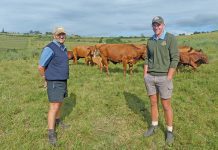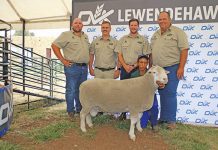Today, almost 15 years later, he’s managed to turn his childhood hobby into a thriving business. He spoke to Mike Burgess about his unique job. Riekert Erasmus (30) has “war wounds” to make a bullfighter blush. “I’ve broken my legs, my ribs, my arms, and my coccyx,” he says. The black eye he’s sporting is courtesy of his first fall of 2010.
“When I was seven a horse ran away with me, straight through a washing line, slicing my stomach open. My guts were hanging out!” But these are just occupational hazards to Riekert. “You can’t be scared on the job,” he says. “I’ve just about broken all my bones, but I enjoy it – I’ll do this until I can’t walk.”
The job he’s referring to is breaking in wild horses. He has his dad Rassie, the operations manager at the Queenstown Stock Theft unit, to thank for his ability to get back onto a horse after being thrown, an important prerequisite in this line of work. “My dad used to break in horses as a hobby and he was tough on me. If I fell off, he’d say I had to get back on,” chuckles Riekert. “Today I’m thankful, because I’m not scared of horses.”
By the age of 16, he was earning money breaking in horses near Queenstown. By the time he left school, he had developed a marketable skill, and like many youngsters, he decided to go abroad. In 1999 he left for New Zealand, and for the next seven years he broke in horses for various clients in Auckland, Wellington and Dunedin.The experience was invaluable, and the horses he dealt with were reasonably accustomed to people compared to those in Africa. “Working with those tame horses in New Zealand gave me confidence. I never broke any bones,” explains Riekert.
“Here we have very wild horses. A guy phones me to come and break in four to five stallions. I get there and they’re 10 years old and have never seen people. Horses like these are very dangerous. They can kill you.” Since returning to South Africa in 2006, he’s broken in about 500 horses. He says he always attempts to bring a holistic service to clients, including training workers in horse-handling skills, farrier services, and selling equestrian equipment. “A happy client will want you back,” says Riekert. “I don’t finish a job and forget about the client. I’m always available to sort out any problems they might have.”
Basic rules when breaking in a horse
The entire process from first making contact with the horse to actually getting on and riding it shouldn’t take longer than an hour, says Riekert, who believes a horse can only concentrate effectively for that length of time. “Older horses get fed up and stop concentrating. At this stage I stop. I prefer to take the gear off and let them go, because tomorrow they’ll be better again,” he says.
The best age to break in a horse is between 18 and 24 months, as older horses are less pliable and more dangerous. “Older horses take a lot longer to tame,” explains Riekert. “The bigger and stronger they are, the longer and more dangerous the job is.” First, horses are halter-trained in a horse ring 12m in diameter. In a process called “lunging”, the horse is taught various commands, including stopping, being led and turning off the front and hind quarters.
When the horse is “bagged down” it is stroked with a fertiliser bag, which accustoms it to being touched, while getting it used to nearby noises and movements. Next, a saddle and bridle are secured on the horse. This is always a challenge, especially when tying the girth, says Riekert. If a horse is especially difficult, a rope can be tied around its stomach to desensitise it.
“Some horses are fine when I put on the saddle, but as soon as I tighten the girth, they try to throw the saddle off. It’s not a method I often use, but I put a rope around their belly, and even if it goes to their flanks, I pull a bit and let them buck for a while, so they see they can’t get rid of it. Then I gradually release pressure on the rope until the horse learns to stop bucking.”
The trainer needs to keep eye contact with the horse, make no sudden movements and ensure the horse is concentrating on the tasks at hand by noting certain behaviour. “When a horse puts its head down, it’s a sign of submission. When its ears follow you, it’s concentrating on you,” he explains. “At all times you have to have eye contact with a horse. I call it ‘locking them’. The minute it starts cooperating, take the pressure off using the ropes. Then the horse will realise, ‘this guy knows something’. That’s the secret.”
Next, long ropes are attached to the bit and run through the stirrups. Using these ropes, the horse is steered around the horse ring in preparation for actual riding. Once Riekert is on the horse, he rides it every day for a few days, before handing it over to its new rider. He’s well known for his fast and effective work, having broken in 30 horses in six weeks for one farmer, and 16 in six days for another.
Dealing with “problem horses”
Riekert says a “problem horse” is an animal that has learnt dangerous habits in attempting to get the better of the people who have tried to tame it. “Rather give me a wild horse that’s 10 years old and I’ll do magic with it, than a horse someone else has tried to break in and left,” he says.
“A wild horse that’s beaten somebody else is a ticking time bomb for me.” Such problem horses are fearful of humans because of their experience at the hands of forceful trainers who have invariably used bad bits. “My father taught me that any problem in a horse starts in its mouth,” says Riekert. “A curb bit in a horse’s mouth is painful, while a snaffle bit isn’t. I’ve often come to people with a difficult horse, changed the bits and ridden it.
“Fear breeds anger. Once a horse puts its ears down and comes for you, you have big problems. It’ll take months to fix a horse like that.” Problem horses should be handled with the greatest of care as they’re highly strung, afraid and aggressive. Reikert’s most valuable tool is blinkers. “If I feel a horse is dangerous, I’ll put blinkers on – it’s magic.”
But even blinkers don’t always work, he admits, as was the case with the horse responsible for his current shiner. “It was the first horse with blinkers on that I’ve ever come off. The minute he felt my weight going onto him, he took off,” he says. But as after every fall, the drill was the same for Riekert. “When I woke up, I got straight back on again.”
Call Riekert Erasmus on 072 226 5386.













